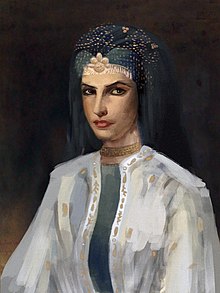This article's tone or style may not reflect the encyclopedic tone used on Wikipedia. (October 2024) |
| Lalla Aisha bint Ali ibn Rashid al-Alami للا عائشة بنت علي بن رشيد العلمي | |
|---|---|
 Modern fantasy image | |
| Governor of Tétouan | |
| Rule | 1515/1519[1] – 1542 |
| Predecessor | Sidi al-Mandri II |
| Born | c. 1491–1495[2] Chefchaouen, Morocco[2] |
| Died | 1552 Chefchaouen, Morocco |
| Spouse |
|
| Dynasty | Wattasid (by marriage) |
| Father | Ali ibn Rashid al-Alami |
| Mother | Lalla Zohra Fernandez[4] |
| Religion | Sunni Islam |
Lalla Aisha bint Ali ibn Rashid al-Alami (Arabic: للا عائشة بنت علي بن رشيد العلمي; c. 1491 or 1495 – 1552),[2][5] commonly known as Sayyida al-Hurra (السيدة الحرة, transl. The Mistress, the Free Woman), was a Moroccan privateer who governed the city of Tétouan from 1515 or 1519 to 1542.[6] As the wife of Moroccan king Abu al-Abbas Ahmad ibn Muhammad, who was her second husband, she belonged to the Wattasid dynasty. She is considered to be "one of the most important female figures of the Islamic West in the modern age."[7]
The era of her life and career was largely marked by a widespread struggle between the Christian world and the Muslim world: the Ottoman Empire had conquered Constantinople in 1453, ending the Eastern Byzantine Empire; the Portuguese Empire had begun conquering ports along the western Moroccan coast around 1487; and the Reconquista had returned the Iberian Peninsula to European Christian rule by 1492, eventually leading to the expulsion or forced conversion of Muslims in Spain.
Al-Hurra split control over the Mediterranean Sea with her ally Hayreddin Barbarossa,[8] an Ottoman corsair who operated in the east while she operated in the west.[9] In 1515, she became the last person in Muslim history to legitimately hold the title "al-Hurra" following the death of her first husband Sidi al-Mandri II, who ruled Tétouan. Her marriage to her second husband marks the only time in Moroccan history that a king married away from the capital city Fez, as al-Hurra refused to leave Tétouan.[7][10]
- ^ "Malika VI: Sayyida Al-Hurra". Muslim Heritage. 2018-02-08. Retrieved 2022-04-09.
- ^ a b c Cite error: The named reference
Lebwas invoked but never defined (see the help page). - ^ Elbl, Martin (2013-12-27). Portuguese Tangier (1471-1662): Colonial Urban Fabric as Cross-Cultural Skeleton. Baywolf Press / Éditions Baywolf. p. 242. ISBN 978-0-921437-50-5.
- ^ Rodolfo Gil. Grimau (2000). Sayyida al-Hurra, mujer marroquí de origen andalusi (in Spanish). Anaquel de estudios árabes.
- ^ Cite error: The named reference
Alifwas invoked but never defined (see the help page). - ^ "Malika VI: Sayyida Al-Hurra". Muslim Heritage. 2018-02-08. Retrieved 2022-04-09.
- ^ a b Cite error: The named reference
SAYYIDA AL-HURRAwas invoked but never defined (see the help page). - ^ Klausman, Ulrike (2010). Women Pirates and the Politics of the Jolly Roger. Perseus Book LLC. p. 98. ISBN 978-1282000018. OCLC 892994261.
- ^ Qazi, Moin (2015). Women in Islam : exploring new paradigms. Notion Press. ISBN 9789384878030. OCLC 906544767.
- ^ Cite error: The named reference
Mernissi18was invoked but never defined (see the help page).